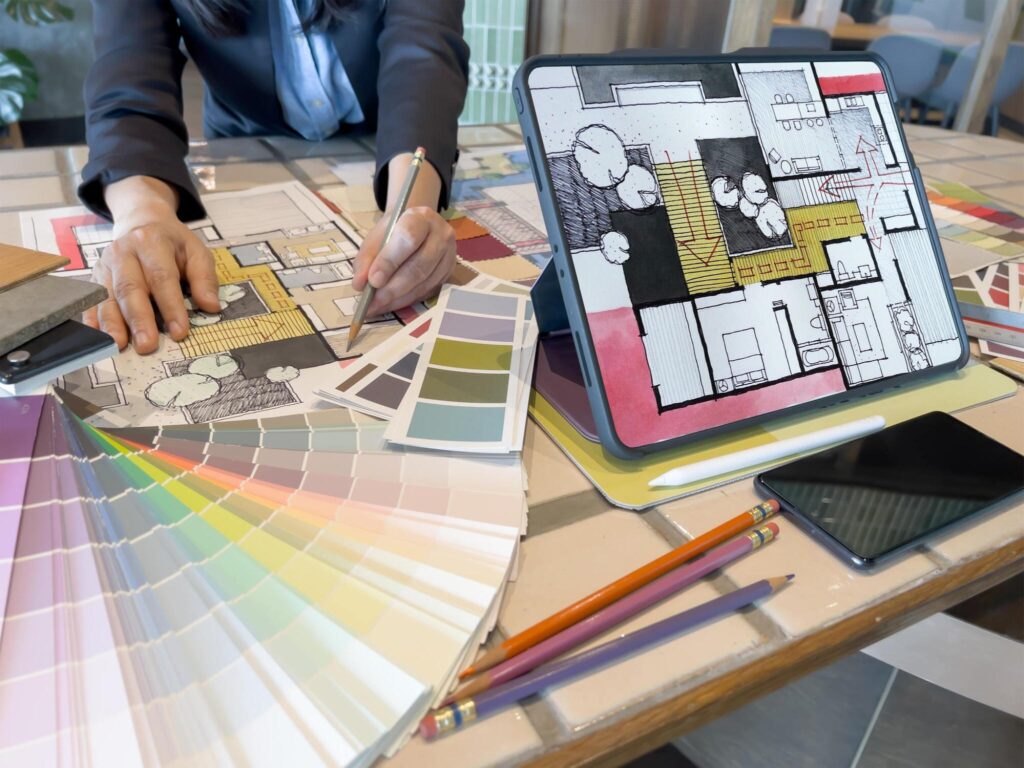Introduction:
Interior design is a fascinating field that combines creativity, functionality, and aesthetics to transform spaces into beautiful sanctuaries. Whether it’s a cozy home, an office space, or a commercial establishment, the art of this is plays a crucial role in shaping our environment. In this article, we will delve into the world of explore its various aspects and benefits.

Interior design is the art and science of transforming the interior spaces of buildings into aesthetically pleasing and functional areas. It goes beyond simply selecting colors and furniture; it involves a careful consideration of layout, lighting, materials, textures, and other elements to create harmonious environments that meet the needs and preferences of the occupants.
One of the primary goals is to enhance the overall experience within a space. This includes creating a sense of balance and harmony through careful arrangement of furniture and accessories. By strategically placing objects in relation to each other, this can achieve visual equilibrium that promotes a feeling of calmness and order.
Functionality is another crucial aspect of interior design. Designers strive to optimize the use of space by ensuring that layouts are efficient, ergonomic, and practical for daily activities. They consider factors such as traffic flow, storage needs, acoustics, and lighting requirements to create spaces that are not only visually appealing but also highly functional.
Color plays a significant role as well. Different colors evoke different emotions and can greatly influence our mood within a space. Interior designers carefully select color schemes that align with the desired atmosphere or theme for each room or area.
Materials also play an essential role in interior design. From natural elements like wood or stone to synthetic materials like glass or metal, designers choose materials based on their aesthetics as well as their durability, sustainability, maintenance requirements, and compatibility with the overall design concept.
In summary, This is about transforming spaces into beautiful yet functional environments that cater to our needs while reflecting our personal style preferences. It combines creativity with technical knowledge to create spaces that not only look visually appealing but also enhance our well-being and improve our quality of life within those spaces.
I. Understanding Interior Design: A Multifaceted Discipline
– Definition of Interior Design
– Importance and Purpose
– Roles and Responsibilities of an Interior Designer
II. Elements of Interior Design: Creating Harmonious Spaces
a) Color Scheme and Palette:
– The Psychology of Colors in Interior Design
– Choosing the Right Color Scheme for Different Spaces
b) Furniture Selection and Placement:
– Ergonomics in Furniture Selection
– Optimizing Space with Smart Furniture Placement
c) Lighting:
– Natural vs Artificial Lighting
– Utilizing Lighting Techniques to Enhance Ambiance
d) Textures and Patterns:
– Incorporating Textures for Visual Interest
– Using Patterns to Add Depth to Designs
III. Styles in Interior Design: Expressing Personalities through Spaces
a) Modern/Contemporary Style:
– Minimalism as the Key Element
b) Traditional Style:
– Richness in Ornamentation
c) Industrial Style:
– Exposing Raw Materials
d) Scandinavian Style:
– Simplicity with Cozy Touches
e) Eclectic Style:
– Blending Different Styles Together
IV. Benefits of Good Interior Design: Beyond Aesthetics
– Enhancing Functionality through Efficient Use of Space
– Improving Health and Well-being with Thoughtful Designs
– Boosting Productivity in Workspaces
– Creating Positive First Impressions for Commercial Establishments
V. Frequently Asked Questions (FAQs)
1. What is the difference between interior design and interior decoration?
Interior design encompasses the overall planning, functionality, aesthetic appeal, while interior decoration focuses on enhancing the existing space by selecting appropriate furnishings, accessories, etc.
2. How can I make my small living space look bigger?
Utilize light colors on walls/furniture, maximize natural light sources through mirrors or sheer curtains, use multi-functional furniture pieces.
3. Can I incorporate my personal style into an interior design project?
Absolutely! A skilled designer will work closely with you to understand your preferences and incorporate them into the overall concept without compromising functionality.
4. How much does it cost to hire an interior designer?
The cost varies based on factors such as project scope/design complexity/location/renovation involved; typically ranges from $2k-$10k per room.
5. How long does an interior design project usually take?
The timeline depends on various factors like project size/complexity/budget; however, a typical residential project may take anywhere from a few weeks to several months.
Conclusion:
Interior design seamlessly blends creativity, functionality, aesthetics, and practicality to transform spaces into unique havens. Whether it’s designing living rooms, kitchens, bathrooms, schools, hospitals, residential properties ,or commercial establishments, the artistry behind creating beautiful yet functional interiors continues to captivate both professionals and individuals keen on improving their surroundings. With ever-evolving trends, new materials, infinite possibilities for customization, interior designers play an integral role in delivering innovative solutions that adapt to evolving lifestyles and societal needs. As we continue exploring new frontiers, it’s essential to recognize how design profoundly influences our daily lives, enriching our experiences within the spaces we inhabit
Leave a Reply